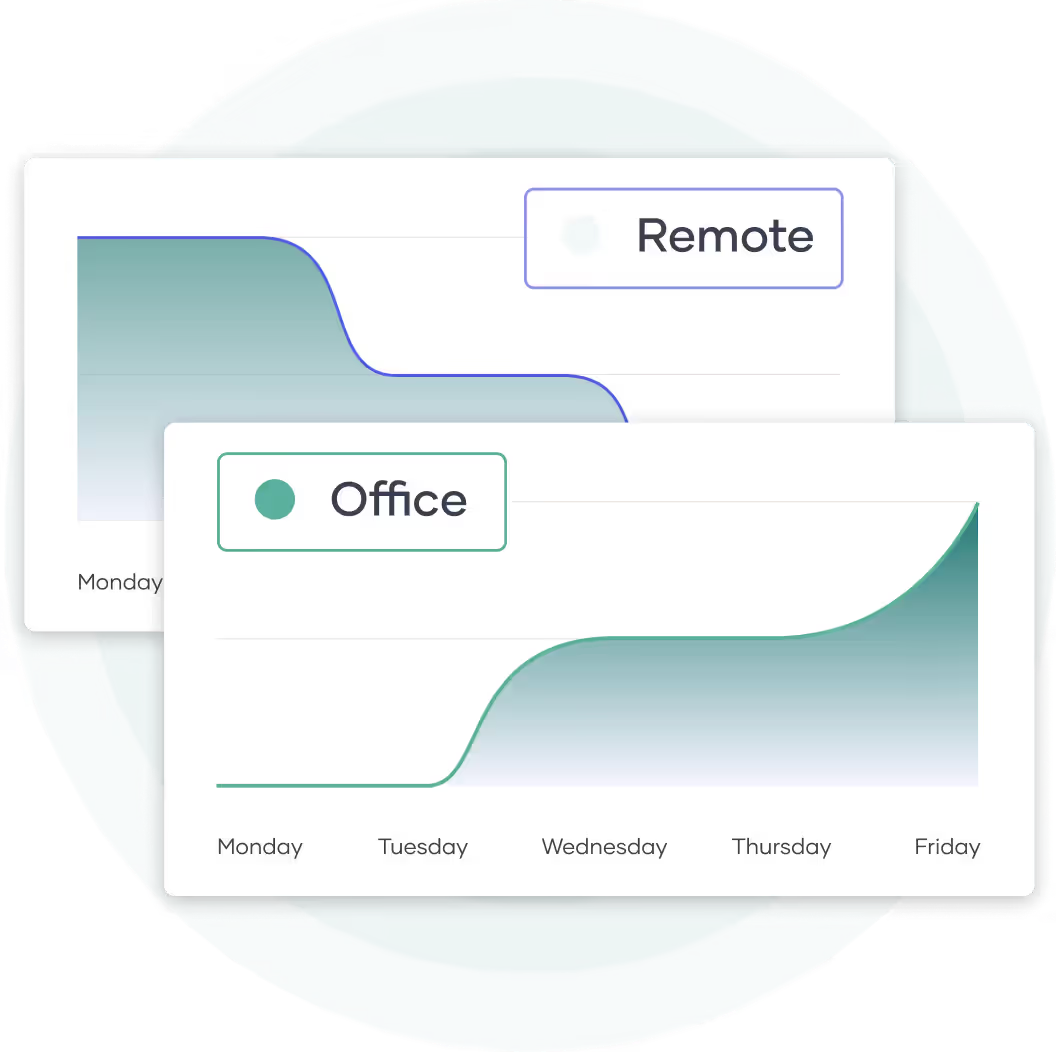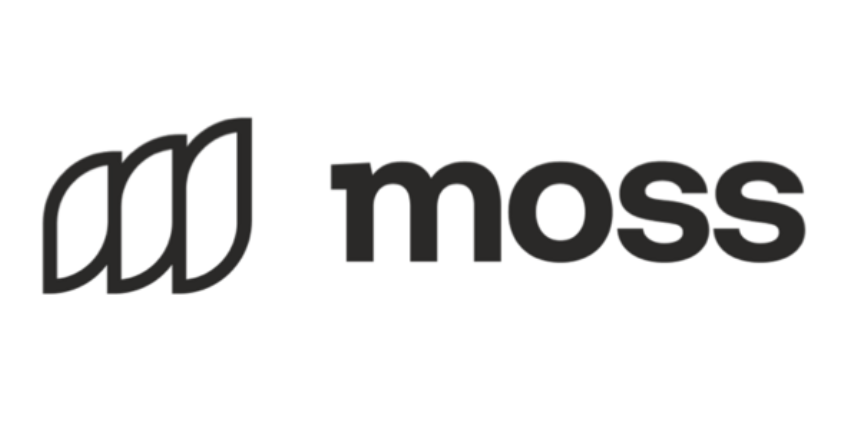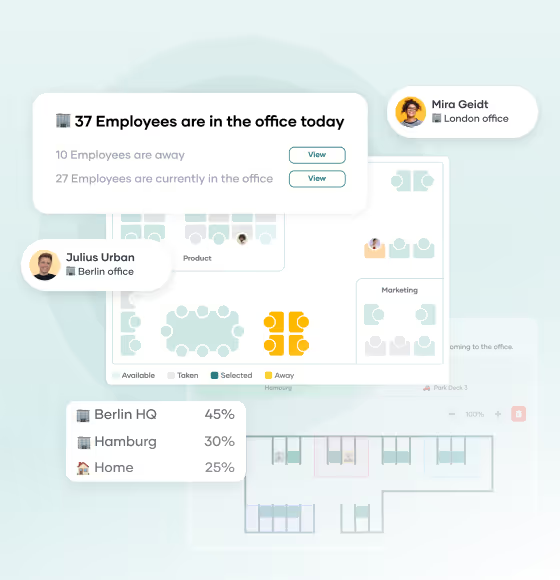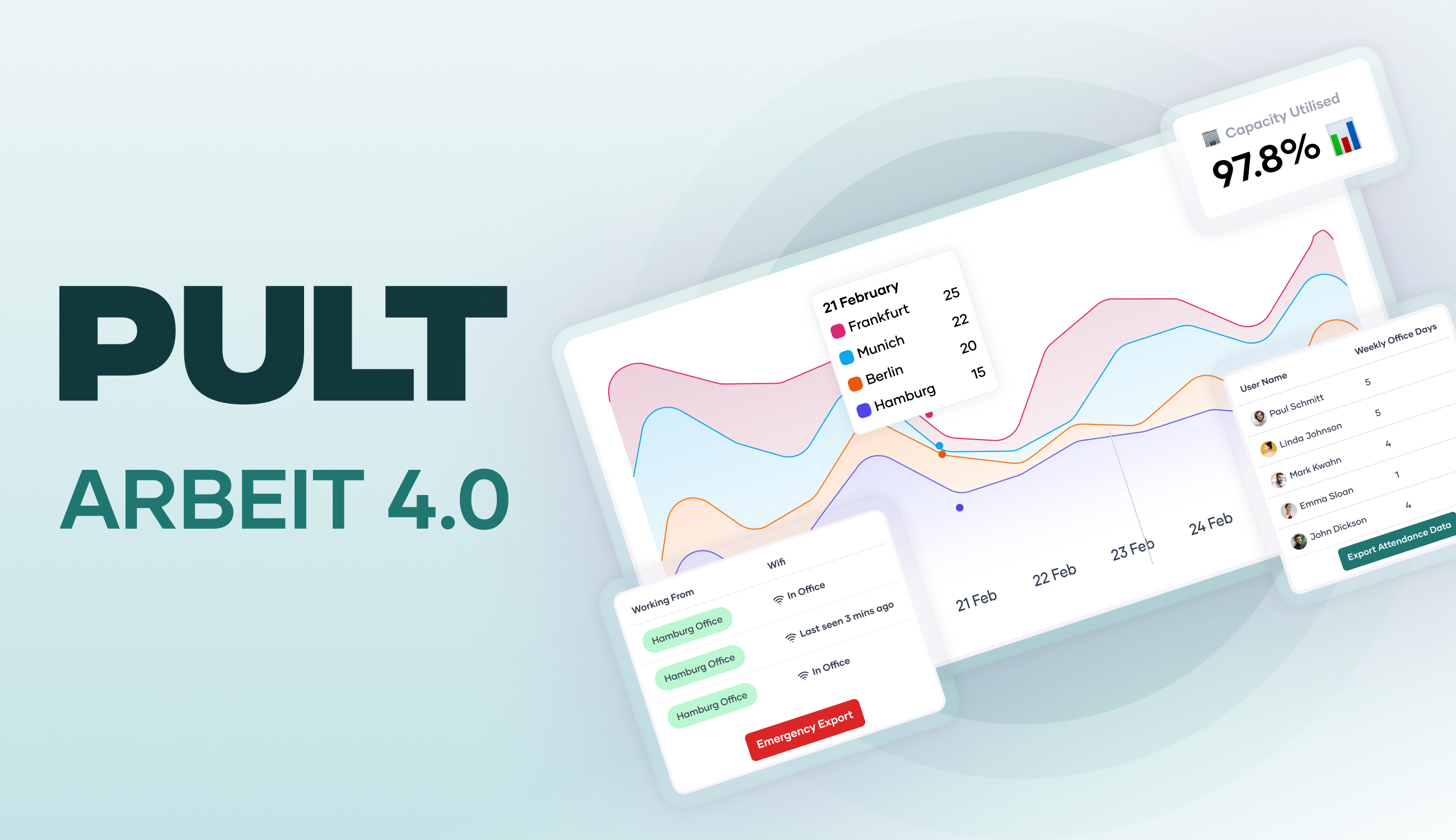The workplace of the future: How people, space, and technology interact

Workplace of the future: TL;DR
- AI in everyday working life: 75% of knowledge workers use generative AI, which is why the right skills and data security are becoming more important.
- Ergonomic & adaptive: Choice of different workplaces depending on the task. Sensor-controlled workplaces for improved air quality, lighting, acoustics, and utilization.
- Data and space management: Sensors and software make occupancy, climate, and energy consumption visible and enable the optimization of workplaces and office space.
- Focus on people: Leadership, learning culture, and mental health are becoming increasingly important for maintaining performance and motivation.
What is the workplace of the future?
The workplace of the future combines the office, home office, and mobile working into a coordinated system. The design of this new type of workplace responds to technological, social, and organizational changes. Work is distributed across multiple physical and digital spaces.
In its “Future of Jobs Report,” the World Economic Forum describes three directions of development:
- Hybrid organizational models with flexible work locations and hours
- Technology: AI, automation, and data integration take over routine tasks
- Human-centric work environments: Workplaces that better meet human requirements for health and balance than before
The three dimensions of the workplace of the future
The workplace of the future is emerging at the interface between people, space, and technology. These three dimensions determine how companies structure work, design their office spaces and premises, and integrate software and AI.
1. Dimension: People
The human dimension encompasses qualifications, work organization, and well-being.
According to the World Economic Forum, analytical thinking, creativity, learning ability, resilience, and technological competence are among the five most important skills for the future. Over 60% of the companies surveyed plan to train employees in AI, data, and communication skills.
Studies by the German Federal Institute for Occupational Safety and Health show that the mental health and social integration of employees in hybrid work, i.e., constantly switching between the office and working from home, are important performance factors.
The BAuA also points out that as digital work density increases, the boundaries between work and leisure become blurred and therefore need to be carefully regulated. Working time documentation, break management, and technical disconnect options (right-to-disconnect regulations) are considered effective preventive measures.
2. Dimension: Space
The workplace of the future is increasingly moving away from the traditional individual workstation and is instead becoming more of a zone. Employees can choose between different workstations within the office, each of which is designed for different purposes.
- Ergonomics: Furniture can be adjusted to suit individual body types using memory presets and controls via an app or workplace ID.
- Customization: Connecting to health and exercise apps enables personalized activity recommendations for each employee.
- Sensors: Sensors detect presence, temperature, air quality, brightness, and frequency of use; they control lighting and climate.
- Lighting control: Circadian lighting adjusts color temperature and brightness throughout the day to stabilize concentration and sleep patterns.
- Acoustics: Workplace design includes sound-absorbing surfaces, variable partitions, or sound masking to minimize acoustic stress in open-plan offices.
- Materiality: Use of natural materials, wood, and textiles to improve indoor climate and psychological well-being.
- Biocomponents: Greenery in the form of hydroponics, hanging plants, plant room dividers, and moss wall art increases humidity and has been proven to reduce stress levels.
- Sustainability: Furniture consists of modular, repairable, and recyclable components with a documented carbon footprint.
3. Dimension: Technology
The technological dimension describes the use of software, increasingly influenced by AI and overall with a view to simplifying human work.
The Microsoft Work Trend Index Study 2025 shows that generative AI is used in 75% of knowledge work, including text creation, information processing, and data analysis. This development is leading to new forms of work: so-called human-agent teams combine human decision-making capabilities with algorithmic support.
The workplace of the future will use IoT sensors, presence detection, and room data. These systems enable comprehensive data analysis of room usage, energy consumption, and ergonomic behavior.
Added to this is the widespread use of AI, for example in digital workplaces, data management systems, and collaboration software.
How do I design the workplace of the future?
The future workplace should meet the mental and physical needs of employees much more than before. Old room concepts are being broken down and spaces are being used according to actual needs, sometimes in different ways every day. The hardware used, as well as the skills and mindset of the employees, enable the use of software and technology that is close to the state of the art.
1. Assess the initial situation
Start by taking stock of the existing office space and its use, the existing technology and furniture, and the employees' expectations of the company. Use occupancy data, feedback surveys, and interviews to do this.
- Analyze how and where work is done, for example, through presence detection in PULT Presence, workplace sensors, or surveys.
- Determine the utilization rate per room type (individual workstations, team areas, meeting rooms) to identify over- or under-occupancy.
- Record ergonomics and comfort issues: light, noise, temperature, lack of movement.
- Include results from risk assessments and health reports.
Based on this, determine what types of workstations your company will need in the workplace in future, such as individual workstations in quiet zones for quiet and concentrated work, areas for teamwork, meeting rooms, or attractive break areas.
Tip: With PULT, you can measure office utilization without sensors, gradually replan and optimize office space, and easily conduct surveys among employees.
2. Optimize space and equipment
- Provide height-adjustable desks with memory function, ergonomic chairs, and lighting that can be adjusted individually for each workstation.
- Set up workstations so that employees can regularly switch between sitting, standing, and moving around. Walking pads, i.e., treadmills with low speeds, are suitable for this purpose.
- Design the workplace and zones for teamwork in a modular way, with rollable partitions, tables, chairs, and presentation technology.
- Place plants and natural materials around the space to improve air quality and well-being.
3. Digitalization and employee skills
- Use sensors that measure temperature, CO₂ levels, light, and presence. The data is used to automatically control climate, lighting, and energy consumption.
- Work and administration should be digital as far as possible. Equip your team with the appropriate technology, starting with software and additional hardware, such as tablets for handwritten notes, drawings, and sketches.
- Train your team in the use of AI tools and create a broad understanding of their advantages, but also the associated problems in the digital workplace of the future.
4. Monitoring
Regularly review all measures within the three dimensions of the workplace of the future. Conduct surveys and annual workplace audits for this purpose.
The development of the workplace of the future is never complete. Your employees' demands change and technology continues to evolve. Therefore, plan for regular adjustments and check whether and which measures are effective.
Tip: In PULT Office Insights, you can easily conduct surveys among your employees.

Designing the workplace of the future with PULT
The future of the workplace is created in your company through the interaction of many factors:
- Spaces and zones that enable different ways of working.
- Technology and software that takes care of routine tasks and works reliably.
- Employees who are ready for change and develop future-proof skills.
- A culture that ensures people feel comfortable in the office.
To ensure that you can approach the process of creating future-proof workplaces in a targeted manner rather than relying solely on gut feeling, you need reliable data, which you can obtain from PULT:
- Office Insights: PULT shows you in real time how heavily your office space, rooms, and workstations are being used. Based on this information, you can plan your space to meet the new demands of the workplace of the future.
- PULT Presence: In addition to booking data, Presence provides you with real attendance figures. As soon as laptops or smartphones connect to the company Wi-Fi, office attendance is automatically recorded. This gives you a realistic picture of how many employees are actually in the office, regardless of whether they have made a booking in advance.
- Workplace and room booking: Your employees can reliably reserve workstations, meeting rooms, zones, and parking spaces. This ensures that everyone has fair access to existing and newly created resources and that no one is left standing in front of occupied spaces.
{{onpage-cta}}
How will artificial intelligence change the workplace of the future?
AI will automate routine tasks and shorten decision-making processes. Employees will take on more coordinating, creative, and reviewing roles. At the same time, however, the skills needed to monitor AI output should be expanded in order to review the results from a technical perspective.
How do companies measure whether their workplace concept is working?
Occupancy data, air quality, and energy consumption provide objective metrics, while employee feedback supplements important subjective assessments. Companies combine this data and surveys to regularly evaluate and improve space planning, health, and satisfaction.
Which technologies will have the greatest impact on the workplace of the future?
AI assistance systems, room sensors, and ever-increasing connectivity with colleagues will shape the landscape of the future of the workplace. Complemented by automated lighting and climate control, workplaces will emerge that adapt themselves to usage and daily rhythms.
How will the workplace of the future affect corporate culture?
Hybrid work, i.e., switching between the office, home office, and other work locations, is changing the way companies and departments are managed. Trust and a focus on results are replacing attendance monitoring as a cultural guideline.
A new hybrid workplace experience is coming. Start Now. 🎉
Offer your employees the workplace of the future. Get started with PULT now.





















.avif)




